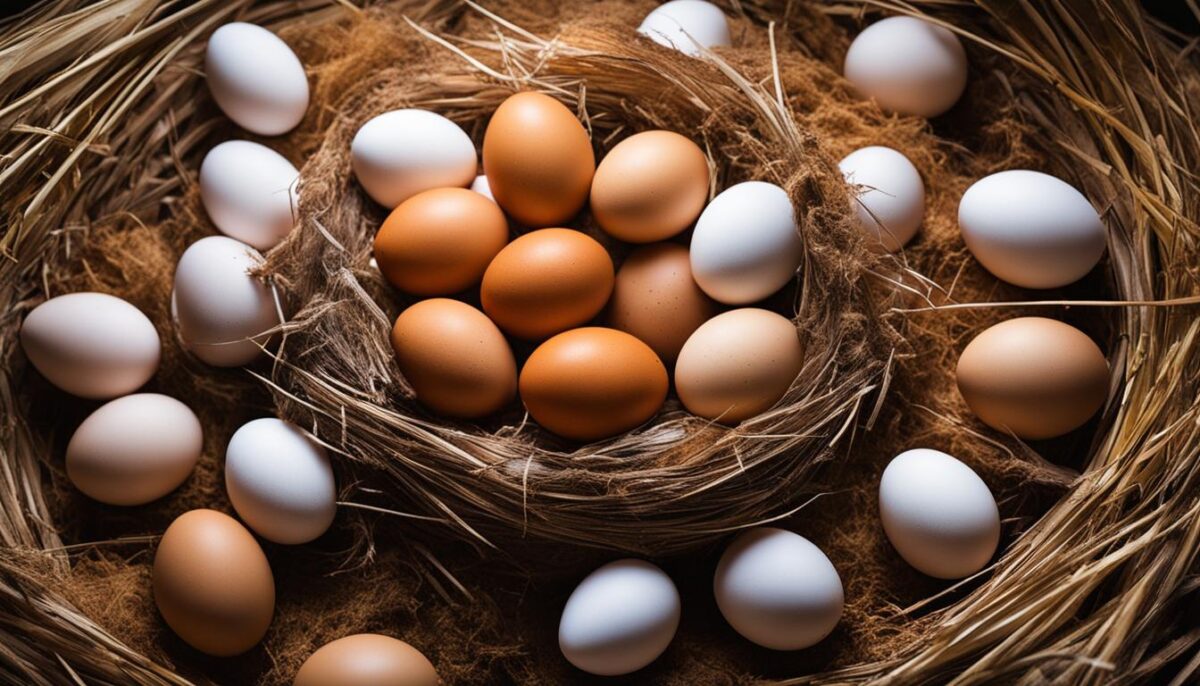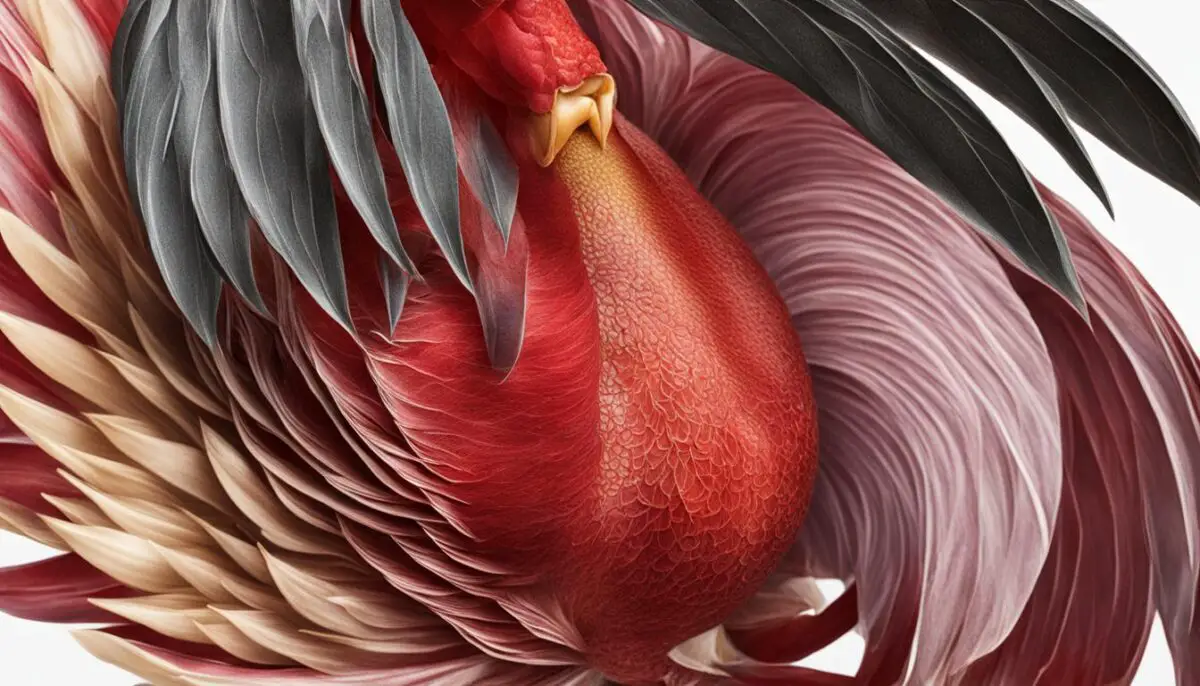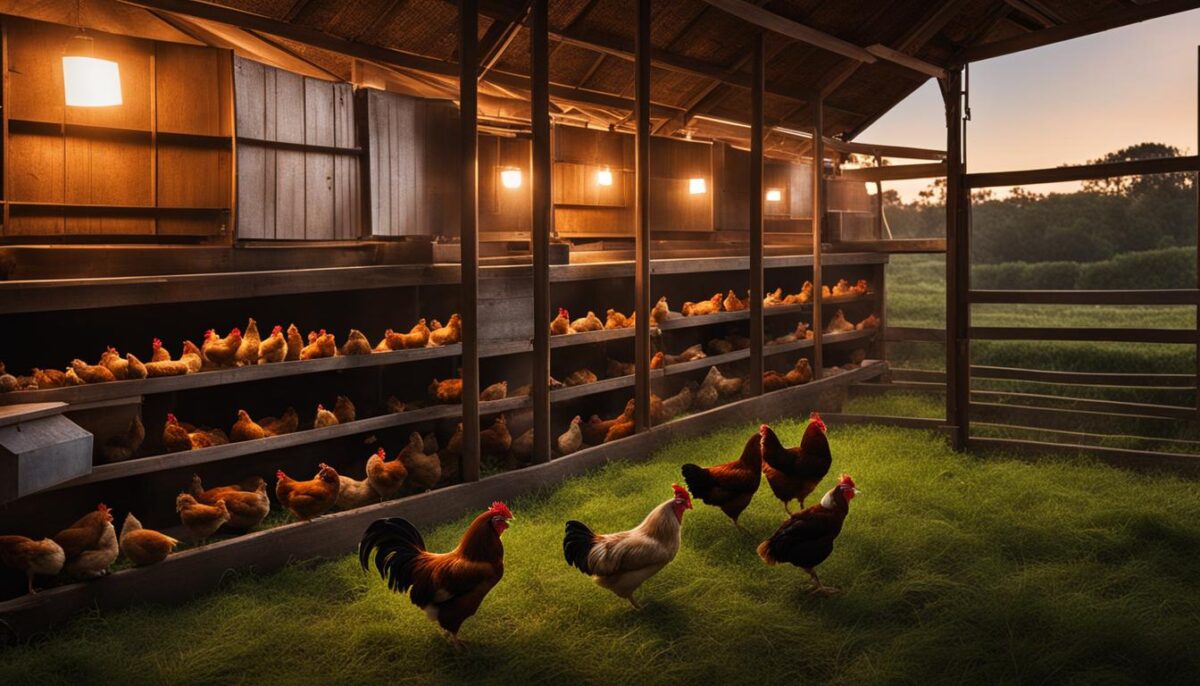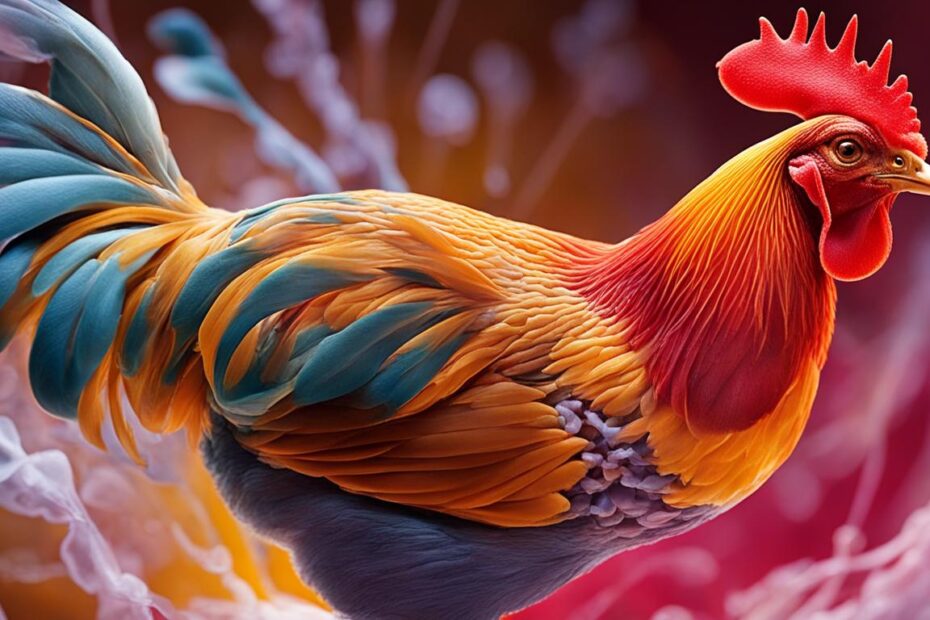Chickens have a unique reproductive process that involves mating between a rooster and a hen. Contrary to popular belief, hens do not require a rooster in order to lay eggs. However, if a rooster is present, the eggs may be fertile and have the potential to hatch into chicks. The mating process is different from mammals, with the transfer of sperm occurring through a “cloacal kiss” where the cloacas of the male and female touch and exchange sperm. This fascinating reproductive process allows for the production of both fertilized and unfertilized eggs in a chicken flock.
Key Takeaways:
- Chickens reproduce sexually through mating between a rooster and a hen.
- Hens can lay eggs without the presence of a rooster, but if a rooster is present, the eggs may be fertile.
- Mating in chickens involves the transfer of sperm through a “cloacal kiss.”
- Both fertile and unfertilized eggs can be produced in a chicken flock.
- Understanding the process of chicken reproduction sheds light on their unique reproductive capabilities.
Mating Habits of Chickens
When it comes to mating, roosters employ various courtship behaviors to impress hens. These behaviors include wing dragging, dancing in circles, and offering food to the hen. Through these actions, roosters try to attract the attention and favor of the hens. The mating act itself involves the rooster mounting the hen from behind, grabbing her feathers with his beak, and transferring sperm to her cloaca. This process, known as treading, can sometimes cause injuries to the hens, such as feather damage or skin damage. Overall, the mating habits of chickens are fascinating and unique to the avian world.
Roosters showcase their elaborate courtship rituals to gain the attention of hens. These behaviors not only demonstrate the fitness and virility of the roosters but also serve as a way to establish dominance within the flock. Wing dragging, where the rooster drags his wings on the ground while circling the hen, is one such behavior that captures the attention of the hens. Additionally, offering food to the hen is another way for roosters to demonstrate their suitability as a mate. By engaging in these courtship behaviors, roosters increase their chances of successfully mating with a hen.
During mating, the rooster mounts the hen from behind and uses his beak to grab onto the hen’s feathers. By transferring sperm to the hen’s cloaca, the rooster ensures that his genetic material has the potential to fertilize the eggs. However, the mating process is not without its risks. The forceful mounting and beak-grabbing actions of the rooster can sometimes lead to injuries in the hens. Feather damage and skin damage are common outcomes of the mating act. Despite these potential risks, chickens have evolved unique behaviors and adaptations to navigate their mating habits successfully.
| Rooster Courtship Behaviors | Mating Process | Potential Risks |
|---|---|---|
| Wing dragging | Rooster mounts from behind | Feather damage |
| Dancing in circles | Transfer of sperm to the hen’s cloaca | Skin damage |
| Offering food to the hen |
“Roosters showcase their elaborate courtship rituals to gain the attention of hens.”
The Unique Behaviors of Roosters
Roosters engage in a range of behaviors to court hens and establish their superiority within the flock. From the mesmerizing wing dragging to the gentle offering of food, these behaviors highlight the rooster’s physical prowess and suitability as a mate. By engaging in courtship rituals, roosters increase their chances of successfully mating with hens and passing on their genetic material.
Fascinating Mating Process
The actual mating act between a rooster and a hen involves the rooster mounting the hen from behind and transferring sperm to her cloaca. This process, known as treading, ensures that the rooster’s genetic material has the potential to fertilize the eggs. However, the forceful nature of the mating act can sometimes lead to injuries in the hens, such as feather damage and skin damage.
Understanding Chicken Mating
Chicken mating habits are unique and fascinating, showcasing the elaborate courtship behaviors of roosters and the intricate process of sperm transfer. By delving into the mating habits of chickens, we gain a deeper understanding of their reproductive behaviors and the factors that contribute to successful reproduction within a chicken flock.
Reproductive Anatomy of Chickens
Understanding the reproductive anatomy of chickens is crucial in comprehending their unique and fascinating process of sexual reproduction. Both male and female chickens possess a cloaca, a multi-purpose opening that serves as the passage for feces, eggs, and sperm. The cloaca also houses the papilla in roosters, which facilitates sperm transfer during mating.
Female chickens, known as hens, have an additional reproductive organ called the oviduct. This important structure is responsible for the formation and fertilization of eggs if mating occurs. The cloaca of both male and female chickens must come into contact for sperm transfer to take place, a process aptly named the “cloacal kiss.”
To visualize the reproductive anatomy of chickens, refer to the following illustrative table:
| Chicken | Reproductive Organs |
|---|---|
| Male (Rooster) | Cloaca with papilla |
| Female (Hen) | Cloaca, Oviduct |
Understanding the unique reproductive anatomy of chickens sheds light on their ability to produce both fertilized and unfertilized eggs. This knowledge contributes to our overall understanding of these fascinating birds and their remarkable reproductive process.
Egg Production in Chickens
Egg production in chickens is a fascinating process that plays a crucial role in understanding their reproductive capabilities. While hens can lay eggs without the presence of a rooster, the potential for fertilization and the production of fertile eggs exists when mating occurs. Fertile eggs contain the genetic material from both the hen and the rooster, and under the right conditions, they have the ability to develop into chicks.
It’s important to note that not all eggs laid by hens are fertile. The eggs remain fertile for a period of time after mating, allowing multiple eggs to be fertilized by a single mating event. This means that even if a rooster is removed from the flock, the eggs laid within a certain timeframe may still be fertile.
To visually illustrate the process of egg production in chickens, let’s take a look at the following table:
| Stage | Description |
|---|---|
| Egg Formation | The hen’s reproductive system produces an egg in the oviduct. If mating occurs, the egg may be fertilized during this stage. |
| Egg Laying | The fully formed egg is laid by the hen through the cloaca. This egg can be either fertilized or unfertilized, depending on the presence of a rooster. |
| Incubation | If the egg is fertilized and conditions are suitable, it can be incubated to develop into a chick. This process typically takes around 21 days. |
Understanding the process of egg production in chickens sheds light on their reproductive capabilities and the potential for the growth of the next generation of chicks.

Breeding Behavior in Chickens
Understanding the breeding behavior of chickens is crucial in comprehending their reproductive process. Roosters and hens display distinct behaviors during the mating process, which ultimately lead to chick development. Roosters employ various courtship behaviors to attract the attention of hens and initiate mating. These behaviors include wing dragging, dancing in circles, and offering food to the hen. By engaging in these actions, roosters aim to impress and win the favor of the hens.
Once a rooster successfully attracts a hen, the mating act takes place, with the rooster mounting the hen from behind. During this process, the rooster grabs the hen’s feathers with his beak and transfers sperm to her cloaca. This reproductive act, known as treading, ensures the fertilization of the eggs. Hens, on the other hand, display receptive behaviors such as squatting and spreading their wings when they are ready to mate. These behaviors indicate their willingness to engage in the mating process.
If the mating is successful, the hens can go on to lay fertile eggs. Fertile eggs contain the genetic material from both the rooster and the hen, and under suitable conditions, they have the potential to develop into chicks. The breeding behavior of chickens is an essential part of their life cycle and contributes to the next generation’s growth and development.
Table: Comparison of Rooster and Hen Breeding Behaviors
| Roosters | Hens |
|---|---|
| Wing dragging | Squatting |
| Dancing in circles | Spreading wings |
| Offering food to hens | Accepting food from roosters |
The table above provides a comparison of the breeding behaviors exhibited by roosters and hens. Roosters engage in courtship behaviors such as wing dragging, dancing in circles, and offering food to attract hens. Hens, on the other hand, display receptive behaviors such as squatting and spreading their wings. These behaviors form the foundation for successful mating and the subsequent development of fertile eggs.
Understanding the intricacies of breeding behavior in chickens helps shed light on their reproductive capabilities and contributes to the overall knowledge of these remarkable birds.
Life Cycle of a Chicken
The life cycle of a chicken encompasses various stages that contribute to their growth and development. From the fertilization of an egg to hatching and maturing into fully feathered adults, each phase plays a crucial role in the reproductive process of chickens.
1. Egg Formation and Incubation
It all begins with the laying of eggs by hens. These eggs can either be unfertilized or fertilized, depending on whether mating with a rooster has occurred. The fertilized eggs contain the genetic material from both the hen and the rooster and have the potential to develop into chicks. Once the eggs are laid, the process of incubation begins.
During incubation, the eggs are kept at an optimal temperature and humidity to facilitate the growth and development of the chicks inside. This period typically lasts around 21 days, during which the embryos undergo significant transformations.
2. Hatching and Chick Development
After the incubation period, the chicks start to hatch from their shells. They use their beak to crack and break through the eggshell, emerging into the world. At this stage, the chicks are covered in down feathers and are highly dependent on their mothers for warmth and protection.
Over time, the chicks go through a rapid growth process, developing feathers and acquiring the ability to walk and peck for food. Their diet consists of a specially formulated chick starter feed that provides the necessary nutrients for healthy growth and development.
3. Maturing into Adult Chickens
As the chicks continue to grow, they go through various stages of development. Their down feathers are gradually replaced by adult feathers, allowing them to adapt to different weather conditions. During this phase, the chicks also develop their reproductive organs, preparing them for their role in the future reproductive cycle.
Once the chicks reach maturity, they are considered fully feathered adult chickens. They are now capable of mating and reproducing, continuing the life cycle of chickens.
| Life Cycle Stage | Description |
|---|---|
| Egg Formation and Incubation | The laying of eggs by hens and the subsequent incubation process to facilitate chick development. |
| Hatching and Chick Development | The emergence of chicks from their eggs and their growth into young, down-feathered individuals. |
| Maturing into Adult Chickens | The gradual development of chicks into fully feathered adult chickens, capable of mating and reproducing. |
The life cycle of a chicken is a remarkable journey that showcases the incredible reproductive capabilities of these birds. From the intricacies of egg formation and incubation to the growth and development of chicks, each stage contributes to the continuity of the species. Understanding the life cycle of a chicken provides valuable insights into the reproductive processes and behaviors that shape the world of poultry.
Reproductive Health in Chickens
Ensuring the reproductive health of chickens is essential for maintaining fertility and egg quality in the flock. Several factors play a crucial role in promoting optimal reproductive health. One of the key factors is providing a balanced and nutritious diet. Chickens require a diet rich in essential nutrients, such as protein, vitamins, and minerals, to support their reproductive functions. A well-balanced diet can improve fertility rates and contribute to the production of high-quality eggs.
In addition to nutrition, managing stress levels is vital for maintaining reproductive health in chickens. Stress can negatively impact egg production and fertility. Providing a calm and comfortable environment for chickens, free from excessive noise, overcrowding, and predator threats, can help reduce stress levels and promote healthy reproductive function.
Regular veterinary check-ups are also crucial for monitoring and maintaining reproductive health in chickens. A veterinarian can perform examinations, assess reproductive organs, and provide appropriate treatments or interventions if necessary. Monitoring egg quality is another essential aspect of reproductive health. By examining factors such as shell thickness, yolk color, and abnormal egg shapes, farmers can identify potential issues and take corrective measures to ensure optimal fertility and egg quality.
Factors Affecting Reproductive Health in Chickens
Various factors can impact the reproductive health of chickens. The age of the birds is one such factor, with younger chickens being more fertile and productive compared to older ones. Environmental conditions also play a significant role. Extreme temperatures, inadequate lighting, and poor ventilation can all affect the reproductive cycle and overall health of the flock.
Table
| Factors | Effect on Reproductive Health |
|---|---|
| Age of the Chickens | Younger chickens are generally more fertile and productive compared to older ones. |
| Environmental Conditions | Extreme temperatures, inadequate lighting, and poor ventilation can negatively impact reproductive health. |
| Genetic Factors | Inherited traits and genetic predispositions can influence reproductive health and productivity. |
| Disease and Parasites | Illnesses and infestations can impair reproductive function and reduce egg quality. |
By understanding and addressing these factors, farmers can take proactive measures to promote reproductive health in their chicken flocks. Regular monitoring, appropriate nutrition, and a conducive environment are essential for ensuring the continued fertility and productivity of chickens.

Factors Affecting Chicken Reproduction
Several factors can influence the reproductive capabilities of chickens. One significant factor is the age of the chickens. Younger birds are generally more likely to mate and successfully reproduce compared to older ones. As chickens age, their fertility and reproductive abilities may decline. Therefore, it is essential to consider the age of the chickens when planning for breeding and ensuring a healthy flock.
Environmental conditions also play a crucial role in chicken reproduction. Factors such as temperature, lighting, and overall living conditions can affect the reproductive cycle of chickens. Providing suitable nesting environments, optimal lighting conditions, and maintaining appropriate temperatures can help facilitate successful mating and egg production in chickens.
It’s important to note that various other factors can impact chicken reproduction as well. These factors include genetics, overall health, and diet. Genetic factors influence certain traits related to reproduction, while overall health and diet affect fertility and egg quality. By prioritizing these aspects and providing proper care, chicken breeders can create optimal conditions for successful reproduction and maintain a healthy flock.
| Factors Affecting Chicken Reproduction | Description |
|---|---|
| Age of Chickens | Younger chickens have a higher likelihood of successful mating and reproduction compared to older ones. |
| Environmental Conditions | Temperature, lighting, and living conditions can impact the reproductive cycle of chickens. |
| Genetics | Genetic factors influence certain reproductive traits in chickens. |
| Overall Health | The overall health of chickens affects their fertility and reproductive capabilities. |
| Diet | A balanced diet with essential nutrients is crucial for optimal reproductive health in chickens. |
Understanding the factors that affect chicken reproduction is essential for chicken breeders and farmers. By considering age, environmental conditions, genetics, health, and diet, breeders can create an environment that promotes successful reproduction and ensures the overall well-being of their flock.

Conclusion
Chickens have a fascinating reproductive process that involves the mating between roosters and hens. This allows for the potential fertilization and development of eggs, leading to the growth of chicks. However, it is important to note that hens can also lay unfertilized eggs without the presence of a rooster. The life cycle of a chicken includes the incubation and development of chicks from fertilized eggs. This process is influenced by various factors, such as breeding behavior, reproductive health, and environmental conditions.
Understanding how chickens reproduce sexually provides valuable insights into their unique biology. The mating habits of roosters and hens, the reproductive anatomy of chickens, and the production of fertile eggs all contribute to the overall process of chicken reproduction. Moreover, factors like age, environmental conditions, and proper care are crucial in ensuring successful mating and egg development. By considering these factors, farmers and chicken breeders can create optimal conditions for their flocks, leading to healthy and thriving chicken populations.
In conclusion, the reproductive journey of chickens is a complex and remarkable phenomenon. From courtship behaviors to the development of chicks, this process showcases the incredible adaptability and diversity of these birds. By delving deeper into the intricacies of chicken reproduction, we gain a deeper appreciation for their remarkable abilities and a better understanding of how to support their overall well-being.
FAQ
How do chickens reproduce sexually?
Chickens reproduce sexually through mating between a rooster and a hen. The rooster transfers sperm to the hen’s cloaca, and if fertilization occurs, the eggs have the potential to develop into chicks.
Do hens need a rooster to lay eggs?
No, hens do not require a rooster to lay eggs. Hens can lay unfertilized eggs on their own. However, if a rooster is present, the eggs may be fertile and capable of hatching into chicks.
How do roosters attract the attention of hens?
Roosters employ various courtship behaviors to impress hens, such as wing dragging, dancing in circles, and offering food. These behaviors are aimed at attracting the attention and favor of the hens.
What is the mating process for chickens?
The mating process involves the rooster mounting the hen from behind, grabbing her feathers with his beak, and transferring sperm to her cloaca. This process, known as treading, facilitates the transfer of sperm and fertilization of the eggs.
How do chickens fertilize eggs?
Chickens fertilize eggs through a process called the “cloacal kiss.” The cloacas of the male and female chickens touch, allowing for the exchange of sperm. This unique reproductive anatomy enables chickens to reproduce sexually.
Can hens lay fertile eggs without mating?
No, hens can only lay fertile eggs if mating occurs. Fertilization happens when the sperm from the rooster combines with the egg in the hen’s oviduct. Without mating, the eggs laid by hens will be unfertilized.
What is the incubation period for chicken eggs?
The incubation period for chicken eggs is typically 21 days. During this time, the eggs develop inside the eggshell, eventually hatching into chicks.
How do chickens go through their life cycle?
The life cycle of a chicken starts with the fertilization of an egg. After incubation, the chicks hatch from their shells and go through a growth period, transitioning into fully feathered adult chickens.
How can I maintain the reproductive health of my chickens?
Maintaining reproductive health in chickens involves providing a balanced diet, managing stress levels, and regular veterinary check-ups. Monitoring egg quality is also important to ensure the reproductive well-being of the flock.
What factors can affect chicken reproduction?
Factors that can affect chicken reproduction include the age of the chickens, environmental conditions such as temperature and lighting, and the availability of suitable breeding environments. These factors play a significant role in the successful mating and egg production of chickens.


